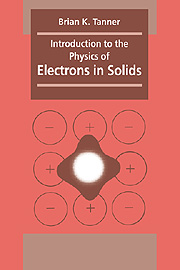Book contents
- Frontmatter
- Contents
- Preface
- Acknowledgements
- 1 The classical free electron model
- 2 Quantum mechanical free electron model
- 3 Application of the Fermi gas model
- 4 Energy bands
- 5 Experimental evidence for band structure and effective mass
- 6 Electrical conduction in semiconductors and insulators
- 7 Semiconductor devices
- 8 Localized electrons
- 9 Magnetism
- 10 Superconductivity
- Appendix 1 Elements of kinetic theory
- Appendix 2 Elements of statistical mechanics
- Appendix 3 Derivation of the Landé g factor
- Index
2 - Quantum mechanical free electron model
Published online by Cambridge University Press: 05 June 2012
- Frontmatter
- Contents
- Preface
- Acknowledgements
- 1 The classical free electron model
- 2 Quantum mechanical free electron model
- 3 Application of the Fermi gas model
- 4 Energy bands
- 5 Experimental evidence for band structure and effective mass
- 6 Electrical conduction in semiconductors and insulators
- 7 Semiconductor devices
- 8 Localized electrons
- 9 Magnetism
- 10 Superconductivity
- Appendix 1 Elements of kinetic theory
- Appendix 2 Elements of statistical mechanics
- Appendix 3 Derivation of the Landé g factor
- Index
Summary
The years of the third decade of the present century were heady times. Old social orders were being swept away, monarchies becoming republics and the United States of America was emerging as a world power. In physics too, revolutions were taking place, none more potent than that which resulted in the emergence of quantum mechanics as a model for the behaviour of sub-atomic particles.
It was Newton who first suggested that light was particulate but during the nineteenth century this view had fallen into neglect. Indeed a number of experiments, for example the classic Young's slits experiment, demonstrated quite conclusively that light was a wave motion. How else could interference fringes occur? However, the experiments on the photoelectric effect demonstrated just as conclusively that light energy was carried in packets, or quanta, and that a continuous wave description was not applicable.
This ‘wave or particle’ dilemma was not unique to the behaviour of light. J. J. Thompson showed that cathode rays were charged, had a well defined mass and had all the properties expected of a beam of particles. Nevertheless, Davisson and Germer showed that diffraction of electrons could take place, an effect made visually much more dramatic by G. P. Thompson's transmission electron diffraction patterns. Nowadays, electron diffraction is used as a routine analytical tool in all advanced metallurgical and materials science laboratories (Fig. 2.1). Clearly new axioms were required.
- Type
- Chapter
- Information
- Introduction to the Physics of Electrons in Solids , pp. 19 - 32Publisher: Cambridge University PressPrint publication year: 1995



